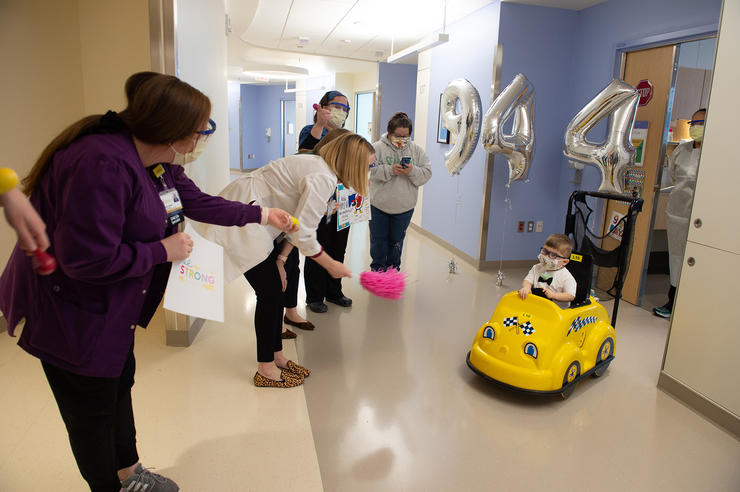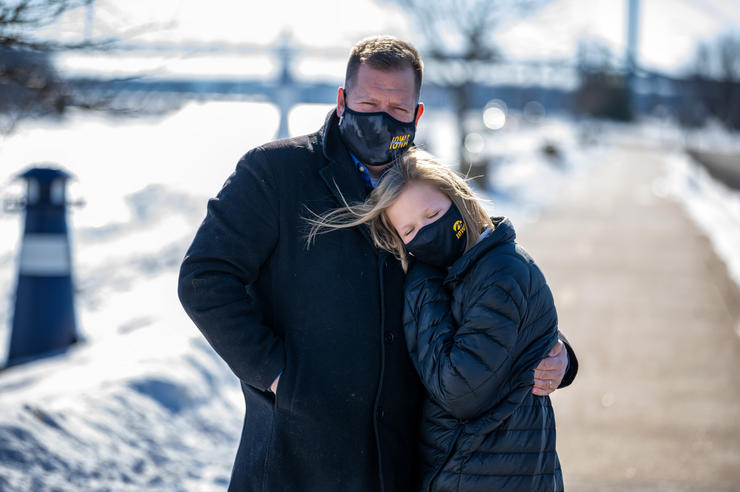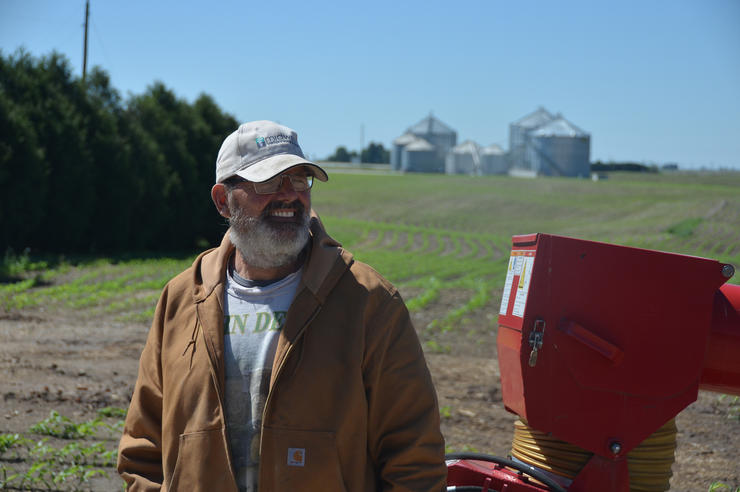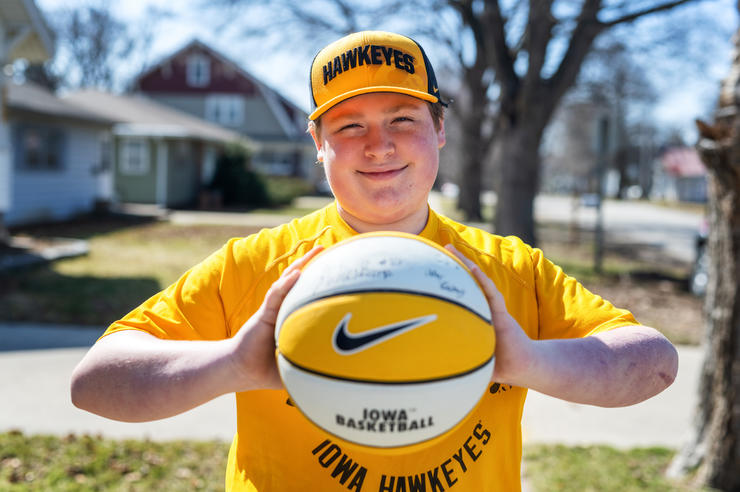Hawkeyes provide vital anesthesia services in Iowa
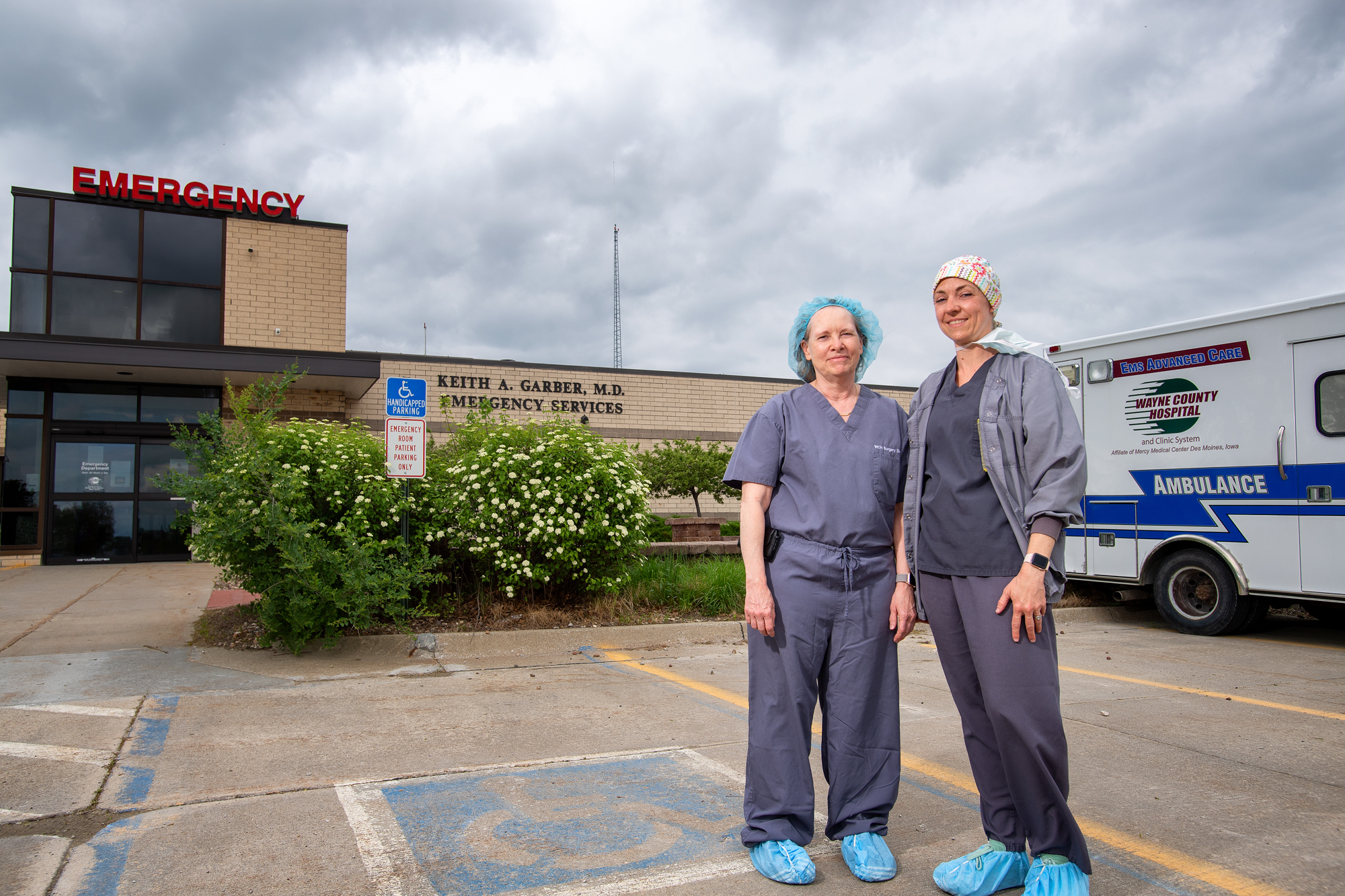
Valerie McKinley (left) and her daughter, Amanda, are two University of Iowa-trained certified registered nurse anesthetists who provide vital services in the state of Iowa. They are shown outside Wayne County Hospital in rural Corydon, Iowa, where Amanda works; Valerie is the president of Bloomfield Anesthetists LLC, which employs 11 CRNAs who provide anesthesia services to hospitals in nine counties in south central Iowa.
Valerie McKinley does a little bit of everything working as a nurse anesthetist.
She might numb a child’s finger so they can get stitches, then give an epidural to a woman giving birth, then anesthetize a patient getting a new knee in the operating room.
And without McKinley, there’s a chance none of those things get done. The hospitals where she works in south central Iowa have no anesthesiologists. All of the anesthetic work at the hospitals—from numbing a minor injury to putting a patient under for surgery and then bringing them back—is done by certified registered nurse anesthetists (CRNAs), registered nurses who have completed several years of graduate education to learn how to administer anesthesia. Of Iowa’s 113 hospitals, 88 rely completely on CRNAs to administer anesthesia to patients, all of them in rural areas.
“I have no idea how they would have anesthesia services at a lot of hospitals without nurse anesthetists,” says McKinley.
The lone training program in the state
The University of Iowa College of Nursing’s Doctor of Nursing Practice (DNP) program—where McKinley earned her degree in 1997—is a key part of providing those professionals, as it’s the only one in the state that educates CRNAs. The program started in 1994 in response to a request to the Board of Regents, State of Iowa, by the Iowa Hospital Association, which was having a hard time recruiting CRNAs, according to Cormac O’Sullivan, clinical associate professor of nursing and program director.
In response, then-Dean Geraldine Felton and John Tinker, chair of the Roy J. and Lucille A Carver College of Medicine Department of Anesthesia, built a program that first awarded master’s degrees and then, in 2010, began awarding the Doctor of Nursing Practice. As the only program in Iowa, it has educated about 30% of the state’s CRNAs. Since its inception, O’Sullivan says, 67% of program graduates have remained in Iowa and 30% have taken up practice in the state’s rural, critical access hospitals.
Since the inception of the University of Iowa Doctor of Nursing Practice program in nurse anesthesia in 1994, 67% of its graduates have remained in Iowa and 30% have taken up practice in the state’s rural, critical access hospitals.
Applicants are required to be a registered nurse with a bachelor’s degree and at least two years of professional nursing experience in intensive care unit settings. O’Sullivan says the program is very competitive, accepting only 14 students for each class. He would like to accept more, but the program is limited by available clinical experiences required by accreditation bodies.
The rigorous three-year program starts with three semesters of classroom work on campus, with students learning graduate-level anatomy, pharmacology, physiology, and pathophysiology; how-to classes and high-fidelity simulated experiences with anesthesia equipment and administering anesthetic drugs; and additional classes in leadership and health care administration. O’Sullivan says the classes they take and the resources available are geared specifically to anesthesia.
“CRNAs use the same textbooks, same anatomy labs, and receive the same clinical education that anyone learning to provide anesthesia would use,” he says. “Everything is similar.”
Gaining experience across Iowa
After their first year of classes on campus, CRNA students begin a series of rotations around the state to rural and community hospitals in places like Bloomfield, Spencer, Waverly, Manchester, Fort Dodge, and Mason City. They also get experience with more complex cases at University of Iowa Hospitals & Clinics and the Iowa City Veterans Affairs hospital.
By the time they graduate, students have had more than 2,500 hours of clinical time and have provided anesthesia for more than 1,100 surgeries while mentored by a CRNA or anesthesiologist. O’Sullivan says it’s the specialized rural rotation experiences that set the Iowa program apart from any other.
“They get a wider variety of experiences than they can in other programs, practicing in so many different types of settings,” he says.
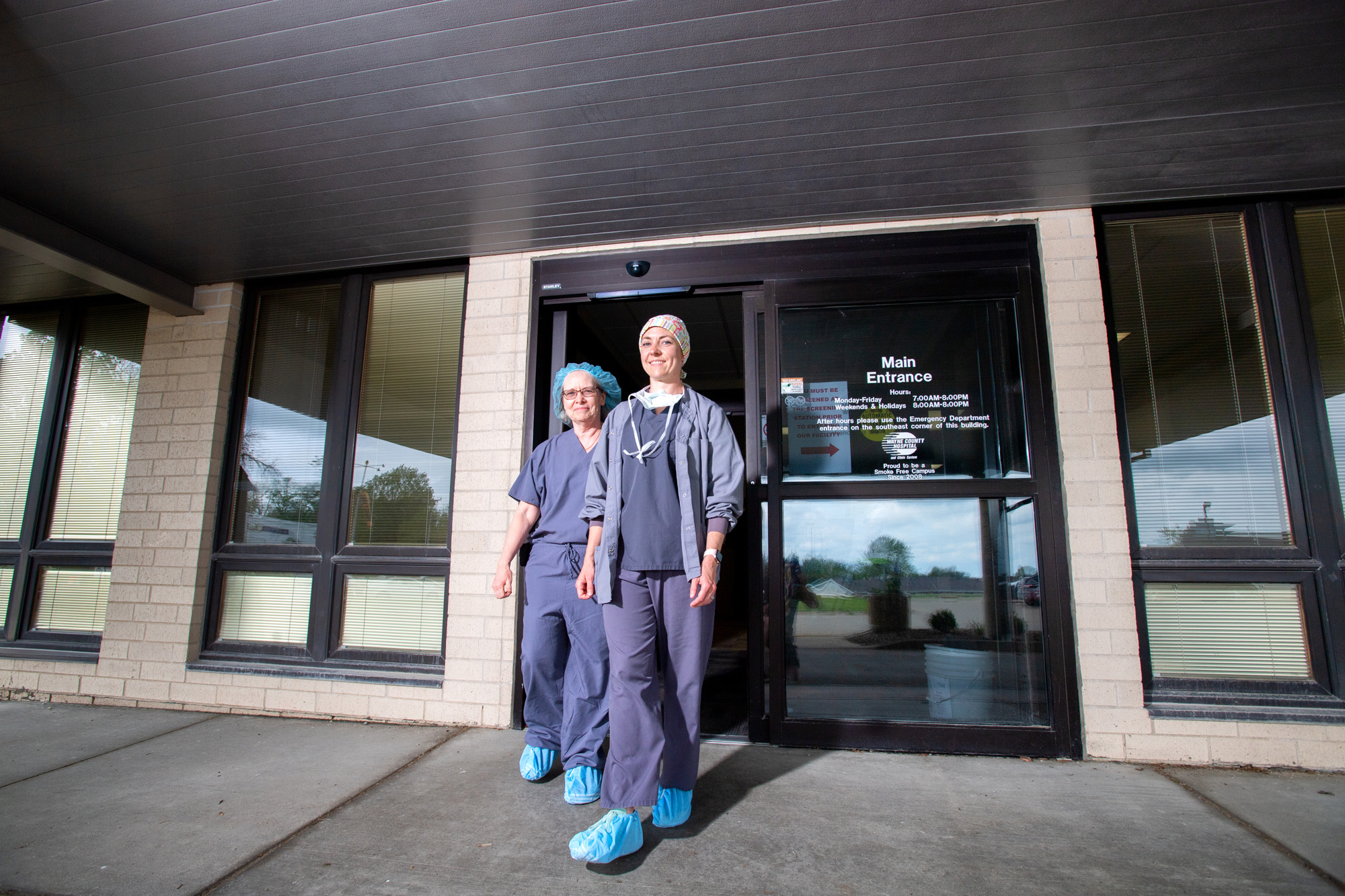
In a single day, it’s not unusual for students to administer anesthesia for a routine procedure like a colonoscopy in the morning, go into the operating room for surgery in the afternoon, and maybe insert a breathing tube during a Code Blue emergency in the ER at the end of the day.
O’Sullivan says CRNAs are important for rural hospitals not just because they provide an important element of patient care. He says much of the revenue generated by hospitals comes from procedures requiring anesthesia. Take away the CRNA and those procedures aren’t done—then a significant portion of revenues the already struggling rural hospitals need to stay afloat all but disappears.
“Nurse anesthetists and anesthesiologists become important people in their communities, and they realize their importance and want to do what’s right for their community,” O’Sullivan says.
CRNAs say they value the independence of the profession—most work as independent contractors and hire themselves out to hospitals—and the variety of work they do, especially in small hospitals where they have to do a little bit of everything. They typically work with six to ten patients a day, and the most frequently cited anesthetics they perform are for joint-replacement procedures, fixing fractures, and other orthopedic procedures, reflecting the aging population of rural areas.
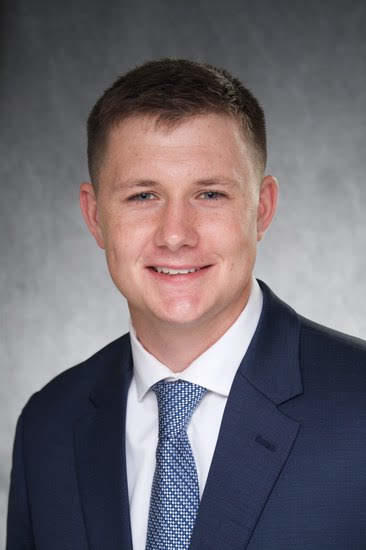
Isaac Butler
Other frequently identified procedures are tonsils, ear tubes, prostate exams, hernia repairs, epidurals and other nerve blocks, general surgery, emergency room calls, and obstetrics and emergency cesarean deliveries in those hospitals that still have a labor and delivery ward.
Isaac Butler is in his final semester in the program and receiving clinical education at the Spencer Hospital in Spencer, Iowa. He learned of the program as an undergraduate in the College of Nursing and says he returned to receive his DNP because he knew how good it was.
“It has a strong reputation and is focused in the sciences, which interested me,” says Butler, a Sibley, Iowa native. It’s also the only program that has such an extensive and wide-ranging rotation system, which gave him the chance to perform lots of different procedures with different medications in different settings.
He says that while CRNAs spend most of their time as anesthetists, they are still nurses first and foremost and still provide a broad range of care to patients.
“You still give holistic care, and that doesn’t go away when we start learning about anesthesia,” Butler says.
“It was one of the hardest things I’ve ever done and is probably the most I’ll ever be challenged. It taught me self-confidence and how to be assertive, and it gives me a chance to take care of my friends and family members who are in town.”
Iowa grads flourish throughout the state
McKinley was a member of the program’s first class and graduated with her master’s degree in 1997. She began her career in Bloomfield, Iowa, and today is the president of Bloomfield Anesthetists LLC, which employs 11 CRNAs who provide anesthesia services to hospitals in nine counties in south central Iowa. She was inspired to join the field by the CRNAs she worked with early in her career as a nurse at the Monroe County Hospital in Albia, Iowa.
“I enjoyed the technical skills and learning new things, and I loved the atmosphere of the operating room,” says McKinley, who was also the first female CRNA in Bloomfield. She says the program is so strong that six members of Bloomfield Anesthetists are Iowa graduates.
“It allowed me to be very successful in my career and allowed me to be a good role model for my daughter,” says McKinley, whose daughter, Amanda, graduated from the Iowa program in 2011 and now works at the Wayne County Hospital in rural Corydon, Iowa.
“It was one of the hardest things I’ve ever done and is probably the most I’ll ever be challenged,” Amanda says of her experience. “It taught me self-confidence and how to be assertive, and it gives me a chance to take care of my friends and family members who are in town.”
Amanda says the varied rotations gave her valuable experience. She worked at hospitals in Omaha, Nebraska, and Des Moines, Spencer, and Manchester, all in Iowa.
“I like working in rural settings, developing close relationships with patients, especially new moms and their babies,” Amanda says. She has plenty of opportunities to do that because the Wayne County Hospital is the only one within 70 miles that still has a labor and delivery unit.
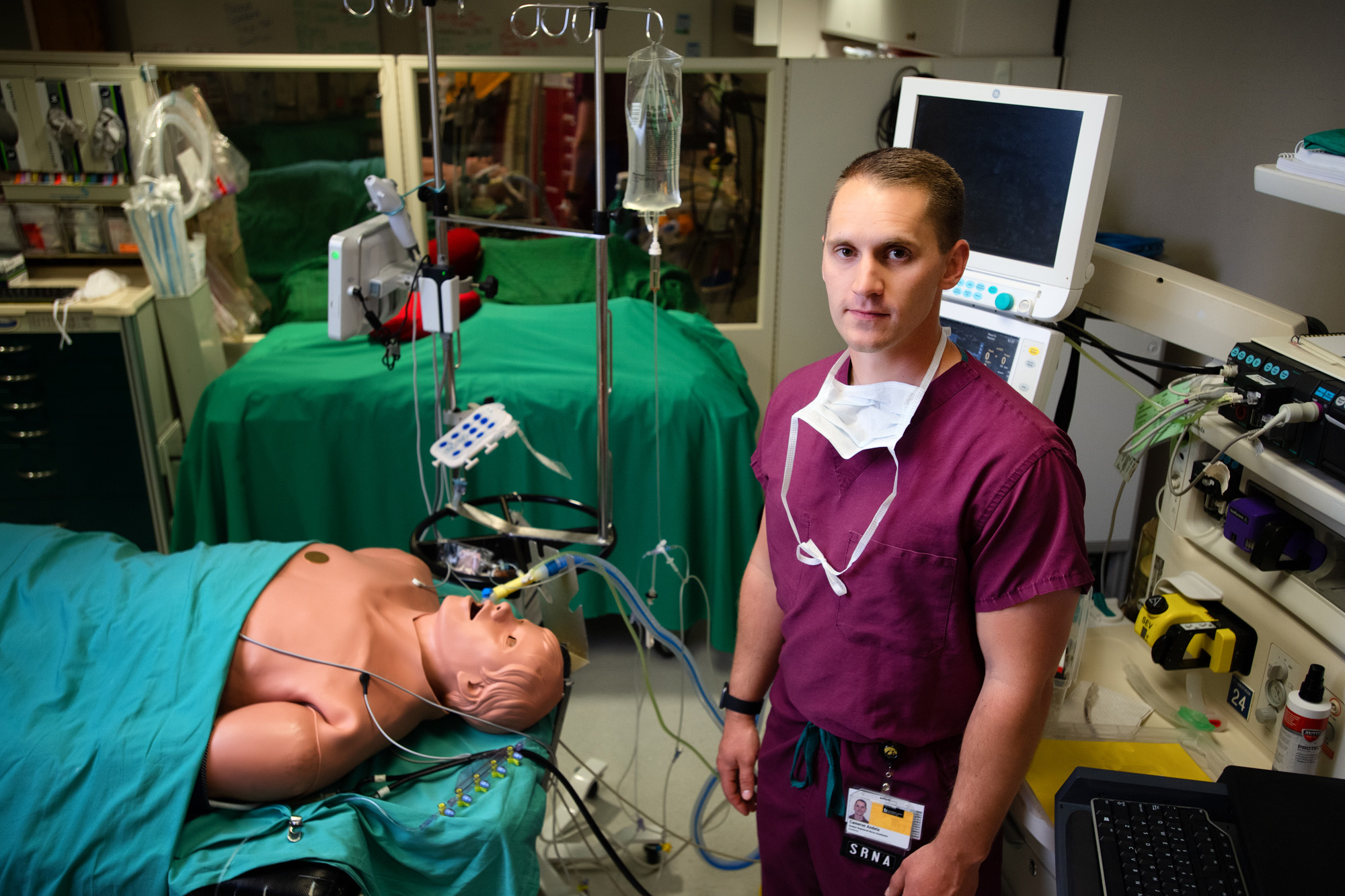
O’Sullivan says the program also attracts a significant number of students from out of state, many of whom stay in Iowa. Cameron Andela is one of them. The Sioux Falls, South Dakota, native had worked for five years at a hospital in his hometown when he decided to become a nurse anesthetist.
“You get to take care of people in their most vulnerable state, and they put their faith in you to wake them back up again,” says Andela, who will begin his clinical rotation at the Spencer Hospital this summer and plans to remain in Iowa when he graduates in 2023. He picked the Iowa program because it’s the strongest in the region and has a wide-ranging curriculum that provides a broad background, with a faculty that challenged him and wanted him to succeed.
Andela says the rotations through rural hospitals were also a huge reason for choosing Iowa.
“You get so many different experiences that expose you to different styles of anesthesia and give you the experiences you need to keep learning,” he says. The experiences will help Andela build a network that can be useful for professional development throughout his career.
“The University of Iowa DNP program in nurse anesthesia is one of a kind and hopes to keep educating remarkable CRNAs for the state and its many rural hospitals for many years to come,” says O’Sullivan.
